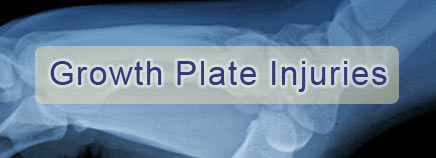
Growth plates are the areas of growing tissue near the ends of the long bones in the legs and arms in kids and adolescents. Also called a physis or epiphyseal plate, a growth plate produces new bone tissue.
An injured growth plate might not do its job properly, which can lead to crooked or misshapen bones, limbs that are too short, or even arthritis. Fortunately, this is rare. With recognition and the right treatment, most growth plate injuries are successfully treated without long-term problems.
About Growth Plates
All long bones have an area called the epiphysis, which is the rounded end of the bone. The long, middle part (or shaft) of the bone is the diaphysis; the area where the bone gets wider at its end is the metaphysis.
In growing kids, growth plates sit between the metaphysis and the epiphysis. Growth plates are at the end of long bones, and grow in length. They’re made up of cartilage, a rubbery, flexible material (the nose, for instance, is made of cartilage).
When a child’s bones are done growing (called reaching skeletal maturity), the growth plates ossify (harden) and the epiphysis fuses with the metaphysis, forming one complete bone.
Girls tend to reach skeletal maturity earlier than boys. Their growth plates usually close around ages 13 to 15, while boys’ growth plates close later, at around ages 15 to 17. Before growth is complete, the growth plates are at risk for fractures (breaks). An adult whose bones have finished growing might simply pull a muscle or a tendon after a fall. But in a child, that same fall could injure the growth plate.

Causes of Growth Plate Injuries
Most of the time, growth plate injuries happen from falling or twisting. Contact sports, like football or basketball, or fast-moving activities like skiing, skateboarding, sledding, or biking, are common causes. Injuries can also happen from activities that require repetitive training, like gymnastics, track and field, or pitching a baseball.
Less common causes of injury include:
- exposure to extreme cold
- medical conditions that affect bone growth
- medicines that can affect bone growth, like treatments for arthritis or cancer
Signs and Symptoms
Signs and symptoms of a growth plate injury are the same as those for a broken bone, and include:
- inability to put weight or pressure on the limb
- pain or discomfort
- inability to move the limb
If you suspect your child has a bone injury, get immediate care with your primary care provider, an orthopedic surgeon, or at an emergency room or urgent care facility.
Diagnosis
In the emergency room or doctor’s office, doctors will ask how the injury happened and may do some physical tests, like applying pressure to the bone or joint to see if it’s unstable.
Because growth plates are cartilage, they may not show up on X-rays. X-rays show just the hard, calcium-containing parts of bones. But doctors can still tell a lot from an X-ray, including whether there’s swelling near the growth plates or a widening of the growth plates that might indicate a fracture.
Treatment
Treatment for growth plate injuries first involves resting and not bearing weight on the affected limb. Often, this means wearing a cast, splint, or brace over the area to prevent movement. Many growth plate injuries are minor, and this may be the only treatment necessary.
Other times, if bones are out of place, they may have to be put back into place through a gentle procedure called a reduction. If needed, a reduction will usually be done in the emergency room or operating room, after the child has been given medicine to lessen the pain. Afterward, the child may wear a cast, splint, or brace to make sure the bones don’t move out of place.
In a complicated injury, surgery might be needed to realign the bones. Surgical plates, screws, or wires might be used to secure the area so that the bone heals normally. After surgery, some kids will wear a cast or splint during recovery.
After the fracture has healed, some kids might need physical therapy to help strengthen the area around the injury, restore normal movement if a joint (like the elbow) was affected, and make sure bones and joints are working normally.
Outlook
Most kids who are treated for growth plate injuries do not have any long-term complications. However, follow-up care is important to make sure bones are healing and continuing to grow normally.

